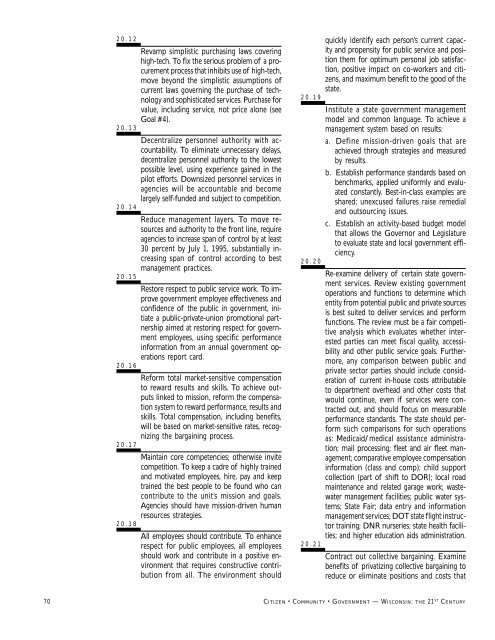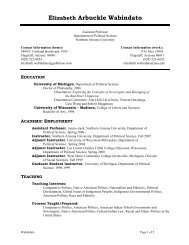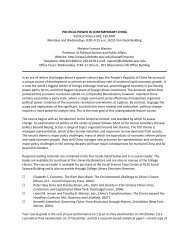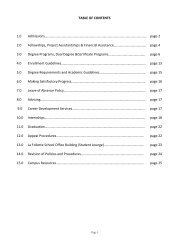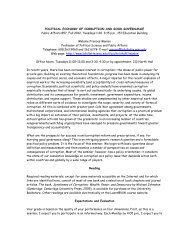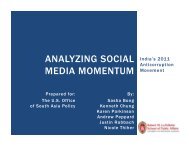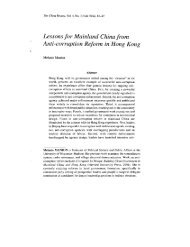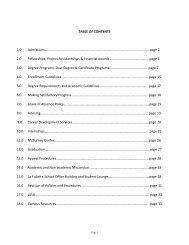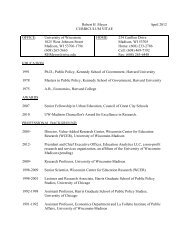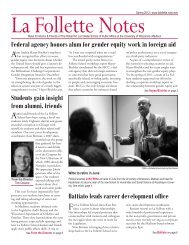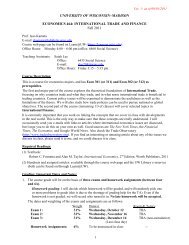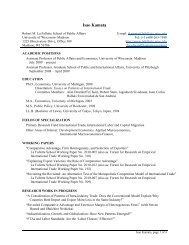SAVE Commission's findings - La Follette School of Public Affairs ...
SAVE Commission's findings - La Follette School of Public Affairs ...
SAVE Commission's findings - La Follette School of Public Affairs ...
You also want an ePaper? Increase the reach of your titles
YUMPU automatically turns print PDFs into web optimized ePapers that Google loves.
20.12<br />
20.13<br />
20.14<br />
20.15<br />
20.16<br />
20.17<br />
20.18<br />
Revamp simplistic purchasing laws covering<br />
high-tech. To fix the serious problem <strong>of</strong> a procurement<br />
process that inhibits use <strong>of</strong> high-tech,<br />
move beyond the simplistic assumptions <strong>of</strong><br />
current laws governing the purchase <strong>of</strong> technology<br />
and sophisticated services. Purchase for<br />
value, including service, not price alone (see<br />
Goal #4).<br />
Decentralize personnel authority with accountability.<br />
To eliminate unnecessary delays,<br />
decentralize personnel authority to the lowest<br />
possible level, using experience gained in the<br />
pilot efforts. Downsized personnel services in<br />
agencies will be accountable and become<br />
largely self-funded and subject to competition.<br />
Reduce management layers. To move resources<br />
and authority to the front line, require<br />
agencies to increase span <strong>of</strong> control by at least<br />
30 percent by July 1, 1995, substantially increasing<br />
span <strong>of</strong> control according to best<br />
management practices.<br />
Restore respect to public service work. To improve<br />
government employee effectiveness and<br />
confidence <strong>of</strong> the public in government, initiate<br />
a public-private-union promotional partnership<br />
aimed at restoring respect for government<br />
employees, using specific performance<br />
information from an annual government operations<br />
report card.<br />
Reform total market-sensitive compensation<br />
to reward results and skills. To achieve outputs<br />
linked to mission, reform the compensation<br />
system to reward performance, results and<br />
skills. Total compensation, including benefits,<br />
will be based on market-sensitive rates, recognizing<br />
the bargaining process.<br />
Maintain core competencies; otherwise invite<br />
competition. To keep a cadre <strong>of</strong> highly trained<br />
and motivated employees, hire, pay and keep<br />
trained the best people to be found who can<br />
contribute to the unit’s mission and goals.<br />
Agencies should have mission-driven human<br />
resources strategies.<br />
All employees should contribute. To enhance<br />
respect for public employees, all employees<br />
should work and contribute in a positive environment<br />
that requires constructive contribution<br />
from all. The environment should<br />
20.19<br />
20.20<br />
20.21<br />
quickly identify each person’s current capacity<br />
and propensity for public service and position<br />
them for optimum personal job satisfaction,<br />
positive impact on co-workers and citizens,<br />
and maximum benefit to the good <strong>of</strong> the<br />
state.<br />
Institute a state government management<br />
model and common language. To achieve a<br />
management system based on results:<br />
a. Define mission-driven goals that are<br />
achieved through strategies and measured<br />
by results.<br />
b. Establish performance standards based on<br />
benchmarks, applied uniformly and evaluated<br />
constantly. Best-in-class examples are<br />
shared; unexcused failures raise remedial<br />
and outsourcing issues.<br />
c. Establish an activity-based budget model<br />
that allows the Governor and Legislature<br />
to evaluate state and local government efficiency.<br />
Re-examine delivery <strong>of</strong> certain state government<br />
services. Review existing government<br />
operations and functions to determine which<br />
entity from potential public and private sources<br />
is best suited to deliver services and perform<br />
functions. The review must be a fair competitive<br />
analysis which evaluates whether interested<br />
parties can meet fiscal quality, accessibility<br />
and other public service goals. Furthermore,<br />
any comparison between public and<br />
private sector parties should include consideration<br />
<strong>of</strong> current in-house costs attributable<br />
to department overhead and other costs that<br />
would continue, even if services were contracted<br />
out, and should focus on measurable<br />
performance standards. The state should perform<br />
such comparisons for such operations<br />
as: Medicaid/medical assistance administration;<br />
mail processing; fleet and air fleet management;<br />
comparative employee compensation<br />
information (class and comp); child support<br />
collection (part <strong>of</strong> shift to DOR); local road<br />
maintenance and related garage work; wastewater<br />
management facilities; public water systems;<br />
State Fair; data entry and information<br />
management services; DOT state flight instructor<br />
training; DNR nurseries; state health facilities;<br />
and higher education aids administration.<br />
Contract out collective bargaining. Examine<br />
benefits <strong>of</strong> privatizing collective bargaining to<br />
reduce or eliminate positions and costs that<br />
70 CITIZEN • COMMUNITY • GOVERNMENT — WISCONSIN: THE 21 ST CENTURY


